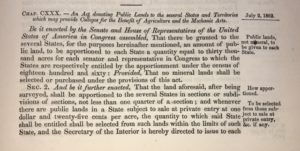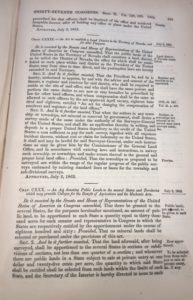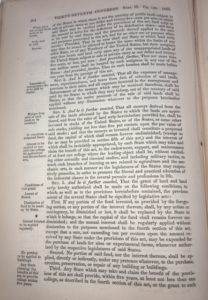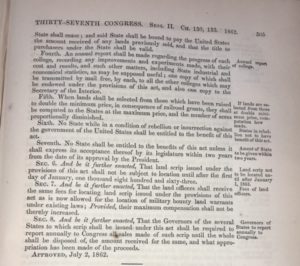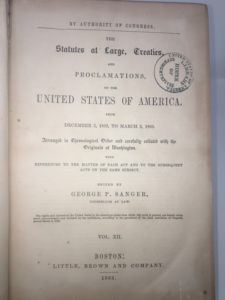MORRILL LAND GRANT COLLEGE ACT of 1862
[37th Congress, Chapter 130, 12 Stat. 503-505, 7 U.S.C. 301]
The Morrill Land Grant Collect Act granted federal land to the states for the establishment of land grant colleges for education in the “agricultural and mechanical arts.” Land was allocated to each state not in rebellion, corresponding to 30,000 acres for each senator and representative in Congress. The Act also provided for instruction in military tactics, which would eventually become the Reserve Officers’ Training Corps (ROTC).
The Morrill Land Grant College Act and the Pacific Railroad Act were signed into law by President Lincoln on July 1 and 2, 1862, at a time when the Union Army was suffering heavy losses in the Civil War.
Many historians agree that these acts by the Thirty-Seventh Congress, along with the Homestead Act of 1862, were some of the most important legislation adopted during the 19th Century. It is especially remarkable that these landmark bills were adopted during wartime.
The concept for the Land Grant College Act was borrowed from the Agricultural College of the State of Michigan (now known as Michigan State University), which was the country’s first agricultural college and served as the model for the Morrill Act which has been referred to as the “Emancipation Act of higher education.”
Iowa was the first state to accept the terms offered by the Morrill Act to fund its existing State Agricultural College and Model Farm (now known as Iowa State University). The first land grant college created under the Act was Kansas State University.
Scores of public universities around the country were established under the Act, including the University of California at Berkley, Clemson, Cornell, Kansas State, Texas A&M, the University of Wisconsin.
The Act was updated in 1890, to include the confederate states. The 1890 Act required each state to either demonstrate that race was not used as a factor in admissions, or to create a separate land grant college for minorities (which facilitated the growth of the historically Black colleges and universities).
Click here for the text of the Act:
Background: After the South succeeded from the Union, the now dominant Republican led Congress adopted laws that Southern members of Congress had opposed since the 1850’s, including the Morrill Land Grant Collect Act and the Pacific Railroad Act. Congress also created the National Banking Act which established a National Banking System and Comptroller of the Currency to assist with the war effort.
By the time the Civil War was over, military mobilization and financial stimulus fostered economic development and expansion in the North.
